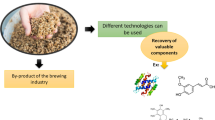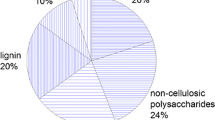Abstract
Dried brewer’s spent grain (DBSG) is rich in tocotrienols (T3) and tocopherols (T) and can be used to produce a valuable oil with the serum cholesterol–lowering functions of lipid-soluble T3. The economic feasibility of extracting oil from DBSG (fat: 3.9–10.6% dry weight, dw) increases with increasing fat content of the feedstock. The objective of this research was to determine whether DBSG can be separated into fractions enriched in fat and T3 by milling and sieving and to characterize the fractions from sieves of different mesh sizes: 500, 800, 850, and 1,000 μm. Six different charges of DBSG were milled and sieved with different techniques ranging in scale from laboratory to industrial. The oil yield of DBSG sieving fractions >500 μm was consistently low (6.6–12.67% dw after Soxhlet extraction with 96% ethanol), as were the levels of T (77.4–185.6 mg/kg of extracted oil), T3 (181.9–538.8 mg/kg of extracted oil), and protein (14.38–25.73% dw). In contrast, oil yields of DBSG sieving fractions <500 μm were higher (12.98–18.09% dw after Soxhlet extraction with 96% ethanol), as were the concentrations of T (188.6–318.0 mg/kg of extracted oil), T3 (516.8–850.2 mg/kg of extracted oil), and protein (26.05–33.30% dw). Furthermore, oil yields were lower (8.24–12.39% dw) after Soxhlet extraction with n-hexane. Milled DBSG sieving fractions <500 μm thus appear to be a suitable feedstock for economical extraction of T3-rich oil and may be useful in developing markets for value-added brewing by-products.

Similar content being viewed by others
Abbreviations
- BSG:
-
Brewer’s spent grain
- DBSG:
-
Dried BSG
- T3:
-
Tocotrienols
- α-, β-, γ-, or δ-T3:
-
α-, β-, γ-, or δ-tocotrienol
- T:
-
Tocopherols
- α-, β-, γ-, or δ-T:
-
α-, β-, γ-, or δ-tocopherol
- dw:
-
Dry weight
References
Ernst and Young Tax Advisors and Regioplan Policy Research. The Contribution made by Beer to the European Economy. Full Report. Edition 2009. available at http://www.brewersofeurope.org/docs/flipping_books/ey_full_2009/index html. Accessed 5 Sep 2010
Santos M, Jimemez JJ, Bartolome B, Gomez-Cordoves C, del Nozal MJ (2003) Variability of brewer’s spent grain within a brewery. Food Chem 80:17–21
Mussatto SI, Dragone G, Roberto IC (2006) Brewers’ spent grain: generation, characteristics and potential applications. J Cereal Sci 43:1–14
Pryma J, Ehrenbergerova J, Belcrediova N, Vaculova K (2007) Tocol content in barley. Acta Chim Slov 54:102–105
Sen CK, Khanna S, Rink C, Roy S (2007) Tocotrienols: the emerging face of natural vitamin E. Vitam Horm 76:203–261
Khanna S, Parinandi NL, Kotha SR, Roy S, Rink C, Bibus D, Sen CK (2010) Nanomolar vitamin E alpha-tocotrienol inhibits glutamate-induced activation of phospholipase A(2) and causes neuroprotection. J Neurochem 112:1249–1260
Serbinova E, Kagan V, Han D, Packer L (1991) Free-radical recycling and intramembrane mobility in the antioxidant properties of alpha-tocopherol and alpha-tocotrienol. Free Radic Biol Med 10:263–275
Yap SP, Yuen KH, Lim AB (2003) Influence of route of administration on the absorption and disposition of alpha-, gamma- and delta-tocotrienols in rats. J Pharm Pharmacol 55:53–58
Mclaughlin PJ, Weihrauch JL (1979) Vitamin-E content of foods. J Am Diet Assoc 75:647–665
Tiwari U, Cummins E (2009) Nutritional importance and effect of processing on tocols in cereals. Trends Food Sci Technol 20:511–520
Sen CK, Khanna S, Roy S (2007) Tocotrienols in health and disease: the other half of the natural vitamin E family. Mol Aspects Med 28:692–728
Qureshi AA, Sami SA, Salser WA, Khan FA (2002) Dose-dependent suppression of serum cholesterol by tocotrienol-rich fraction (TRF25) of rice bran in hypercholesterolemic humans. Atherosclerosis 161:199–207
Liu KS, Moreau RA (2008) Concentrations of functional lipids in abraded fractions of hulless barley and effect of storage. J Food Sci 73:C569–C576
Falk J, Krahnstover A, van der Kooij TAW, Schlensog M, Krupinska K (2004) Tocopherol and tocotrienol accumulation during development of caryopses from barley (Hordeum vulgare L.). Phytochemistry 65:2977–2985
Cubadda R, Marconi E, Panfili G, Graziano M (1999) Localizzazione di beta-glucani e tocoli nell’orzo e loro possibile utilizzazione (Location of beta-glucans and tocols in barley an their possible utilization). Tecnica Molitoria 50:546–556
Panfili G, Fratianni A, Di Criscio T, Marconi E (2008) Tocol and beta-glucan levels in barley varieties and in pearling by-products. Food Chem 107:84–91
Graziano M, Marconi E, Panfili G, Cubadda R (2001) Produzione di sfarinati d’orzo arricchiti in beta-glucani e tocochromanoli mediante macinazione e setacciatura (Production of barley flours enriched in beta-glucans and tocols by grinding and sieving). Tecnica Molitoria 52:866–869
Ferrante MP, Falasca L, Irano M, Panfili G, Marconi E, Cubadda R (2001) Produzione di sfarinati dórzo arricchiti in beta-glucani e tocochromanoli mediante classificazione ad aria (Production of barley flours enriched in beta-glucans and tocols by air classification). Tecnica Molitoria 52:876–883
Lampi AM, Moreau RA, Piironen V, Hicks KB (2004) Pearling barley and rye to produce phytosterol-rich fractions. Lipids 39:783–787
Moreau RA, Flores RA, Hicks KB (2007) Composition of functional lipids in hulled and hulless barley in fractions obtained by scarification and in barley oil. Cereal Chem 84:1–5
Moreau RA, Wayns KE, Flores RA, Hicks KB (2007) Tocopherols and tocotrienols in barley oil prepared from germ and other fractions from scarification and sieving of hulless barley. Cereal Chem 84:587–592
Yeung J, Vasanthan T (2001) Pearling of hull-less barley: Product composition and gel color of pearled barley flours as affected by the degree of pearling. J Agric Food Chem 49:331–335
Peterson DM (1994) Barley tocols—effects of milling, malting, and mashing. Cereal Chem 71:42–44
Qureshi AA, Chaudhary V, Weber FE, Chicoye E, Qureshi N (1991) Effects of brewers grain and other cereals on lipid-metabolism in chickens. Nutr Res 11:159–168
Qureshi AA, Burger WC, Peterson DM, Elson CE (1986) The structure of an inhibitor of cholesterol-biosynthesis isolated from barley. J Biol Chem 261:544–550
Hassona HZ (1993) High-fiber bread containing brewers spent grains and its effect on lipid-metabolism in rats. Nahrung-Food 37:576–582
Qureshi N, Qureshi AA (1993) Tocotrienols: novel hypocholesterolemic agents with antioxidant properties. In: Packer L, Fuchs J (eds) Vitamin E in health and disease. Marcel Dekker, Inc., New York, pp 247–268
Bhatty RS (1999) The potential of hull-less barley. Cereal Chem 76:589–599
Weber FE, Chaudary V, Qureshi AA (1991) Suppression of cholesterol biosynthesis in hypercholesterolemic subjects by tocotrienol of barley ingredients made from brewers grain. Cereal Foods World 36:680
Weber FE, Qureshi N, Chaudhary VK, Bradlow BA, Qureshi AA (1991) Responses of hypercholesterolemic subjects to barley oil extracted from brewers grains. FASEB J 5:A1070
German Federal Office of Consumer Protection, Food Safety (BVL) (2010) Official collection of analysis methods according to § 64 of the German Food and Feed Code (LFGB), edn. 2010–02. Method L17.00–15. BVL, Berlin
Schulte E (2001) Micro method for rapid gravimetric determination of fat content in food after acid treatment. Dtsch Lebensmitt Rundsch 97:85–89
German Federal Office of Consumer Protection, Food Safety (BVL) (2010) Official collection of analysis methods according to § 64 of the German Food and Feed Code (LFGB), edn. 2010–02. Method L16.03–2. BVL, Berlin
Association of Official Analytical Chemists (AOAC) (1980) Official Methods of Analysis of the Association of Official Analytical Chemists, 13th edn. AOAC, Arlington
Sookwong P, Nakagawa K, Murata K, Kojima Y, Miyazawa T (2007) Quantitation of tocotrienol and tocopherol in various rice brans. J Agric Food Chem 55:461–466
Funk W, Damann V, Donnevert G (2005) Qualitätssicherung in der Analytischen Chemie. VCH, Weinheim
Winkler JK, Rennick KA, Eller FJ, Vaughn SF (2007) Phytosterol and tocopherol components in extracts of corn distiller’s dried grain. J Agric Food Chem 55:6482–6486
Andersson AAM, Courtin CM, Delcour JA, Fredriksson H, Schofield JD, Trogh I, Tsiami AA, Aman P (2003) Milling performance of north European hull-less barleys and characterization of resultant millstreams. Cereal Chem 80:667–673
Öztürk S, Özboy Ö, Cavidoglu I, Köksel H (2002) Effects of brewer’s spent grain on the quality and dietary fibre content of cookies. J Inst Brew 108:23–27
Krottenthaler M, Back W, Zarnkow M (2009) Wort production. In: Eßlinger HM (ed) Handbook of brewing. Wiley-VCH, Weinheim, pp 181–185
Fratianni A, Caboni MF, Irano M, Panfili G (2002) A critical comparison between traditional methods and supercritical carbon dioxide extraction for the determination of tocochromanols in cereals. Eur Food Res Technol 215:353–358
Panfili G, Cinquanta L, Fratianni A, Cubadda R (2003) Extraction of wheat germ oil by supercritical CO2: oil and defatted cake characterization. J Am Oil Chem Soc 80:157–161
Yamauchi R (2002) Analysis of vitamin E and its oxidation products by HPLC with electrochemical detection. Lipids 37:515–522
Strohschein S, Rentel C, Lacker T, Bayer E, Albert K (1999) Separation and identification of tocotrienol isomers by HPLC-MS and HPLC-NMR coupling. Anal Chem 71:1780–1785
Mariani C, Bellan G (1996) Content of tocopherols, dehydrotocopherols, tocodienols, tocotrienols in vegetable oils. Rivista Italiana delle Sostanze Grasse 73:533–543
Abidi SL, Thiam S, Warner IM (2002) Elution behavior of unsaponifiable lipids with various capillary electrochromatographic stationary phases. J Chromatogr A 949:195–207
Srinivasan R, To F, Columbus E (2009) Pilot scale fiber separation from distillers dried grains with solubles (DDGS) using sieving and air classification. Bioresour Technol 100:3548–3555
Liu DH, Shi J, Posada LR, Kakuda Y, Xue SJ (2008) Separating tocotrienols from palm oil by molecular distillation. Food Rev Int 24:376–391
Winkler-Moser JK, Vaughn SF (2009) Antioxidant Activity of Phytochemicals from Distillers Dried Grain Oil. J Am Oil Chem Soc 86:1073–1082
Acknowledgments
This work is part of the “Food Network” project funded by the Ministry for Science and Culture of Lower Saxony (Germany) via the Research Association of Agricultural and Nutritional Science of Lower Saxony (Forschungsverbund Agrar- und Ernährungswissenschaften Niedersachsen (FAEN)). The authors wish to gratefully acknowledge Leiber GmbH (Bramsche, Germany), the Max Rubner-Institute Department of Safety and Quality of Cereals (Detmold, Germany), Greenfox Produktions GmbH (Oldendorf/Luhe, Germany), and Davos Life Science (Singapore) for their support.
Author information
Authors and Affiliations
Corresponding author
Rights and permissions
About this article
Cite this article
Bohnsack, C., Ternes, W., Büsing, A. et al. Tocotrienol levels in sieving fraction extracts of brewer’s spent grain. Eur Food Res Technol 232, 563–573 (2011). https://doi.org/10.1007/s00217-010-1419-z
Received:
Revised:
Accepted:
Published:
Issue Date:
DOI: https://doi.org/10.1007/s00217-010-1419-z




